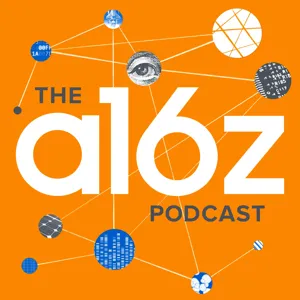a16z Bio + Health #8: How to Innovate within Biopharma with Jay Bradner

Explore " therapeutics" with insightful episodes like "a16z Bio + Health #8: How to Innovate within Biopharma with Jay Bradner", "a16z Bio + Health #6: AI for Biologics With Mark DePristo and Peyton Greenside", "Psychedelics: Striking a Balance Between Benefits and Side Effects", "Journal Club: Slaying the Sleeper Cells of Aging with CAR T" and "Journal Club: Using CRISPR to Prevent Coronavirus and Influenza Infection" from podcasts like ""a16z Live", "a16z Live", "a16z Podcast", "a16z Podcast" and "a16z Podcast"" and more!



In recent years, there’s been a shift in how we think about psychedelics – from drugs of abuse and recreation, to powerful drugs for treating neuropsychiatric conditions such as depression, addiction, and PTSD.
But there’s still a lot we don't know about how they work, and how we can maximize their therapeutic benefits while minimizing their adverse side effects. So this episode of Journal Club discusses a method for striking that balance, from a paper published in Nature last month, “A non-hallucinogenic psychedelic analogue with therapeutic potential“... which could represent a major step forward in psychedelic medicine.
This episode first appeared on Bio Eats World:
https://a16z.com/2021/01/21/journal-club-safer-psychedelic/

CAR T therapy is a groundbreaking medicine that uses engineered T cells to attack cancer. But CAR T cells (that is, chimeric antigen receptor T cells) can be programmed to recognize a huge range of target proteins and cell types. So what other types of cells should we train CAR Ts to recognize and destroy to improve human health?
On this episode of the a16z Journal Club, a16z General Partner Jorge Conde, bio deal team partner Andy Tran, and Lauren Richardson discuss new research published in Nature in which the authors engineer CAR T cells to recognize and kill senescent cells. Cellular senescence is a process where cells stop dividing (sort of go to sleep), and in many cases this can be protective, like its role in tumor suppression, but if too many cells become senescent of if they are not removed, they can trigger inflammation and cause disease, like in atherosclerosis and type 2 diabetes. Critically, senescent cells build up as we age and contribute to a whole host of age-related conditions. In this episode we cover how the authors created these senescence killing (aka senolytic) CAR T cells, the diseases that could be treated with senolytic CAR Ts, the hurdles to getting them into the clinic, and how they could potentially be used to treat aging and possibly improve longevity.
“Senolytic CAR T cells reverse senescence-associated pathologies” in Nature (June 2020) by Corina Amor, Judith Feucht, Josef Leibold, Yu-Jui Ho, Changyu Zhu, Direna Alonso-Curbelo, Jorge Mansilla-Soto, Jacob A. Boyer, Xiang Li, Theodoros Giavridis, Amanda Kulick, Shauna Houlihan, Ellinor Peerschke, Scott L. Friedman, Vladimir Ponomarev, Alessandra Piersigilli, Michel Sadelain & Scott W. Lowe
a16z bio Journal Club (part of the a16z Podcast), curates and covers recent advances from the scientific literature -- what papers we’re reading, and why they matter from our perspective at the intersection of biology & technology. You can find all these episodes at a16z.com/journalclub.

In this episode of a16z bio Journal Club, general partner Vijay Pande, bio deal team partner Andy Tran, and bio editor Lauren Richardson discuss a novel CRISPR-Cas-based anti-viral strategy.
The discussion covers the differences between this newly developed prophylactic strategy, traditional vaccines, and anti-viral drugs; how this strategy can be engineered to target a huge range of coronavirus and influenza strains; and the next steps needed to go from paper to practice:
a16z Journal Club (part of the a16z Podcast), curates and covers recent advances from the scientific literature -- what papers we’re reading, and why they matter from our perspective at the intersection of biology & technology (for bio journal club). You can find all these episodes at a16z.com/journalclub.

In this episode of the a16z Podcast, we take a deep dive into the world of drug development—specifically "undruggable drugs": a category of protein, protein family or even piece of RNA that’s so difficult to target that many researchers don’t even want to touch it.
Jay Bradner, President of the Novartis Institute for BioMedical Research, shares with a16z General Partners Jorge Conde and Vijay Pande, and a16z's Hanne Tidnam, all the new tools, technologies and breakthroughs which are causing the science of therapeutics to explode in some of these areas where it's been incredibly difficult (even impossible) in the past. From molecular glues to cell and gene therapies, Bradner shares the behind-the-scenes science stories of what it really takes to make a new drug that shatters the category of an "undruggable" target.

Descriptions of the mental illness we today call schizophrenia are as old as humankind itself. And more than likely, we are are all familiar with this disease in some way, as it touches 1% of us—millions of lives—and of course, their families. In this episode, we dive into the remarkable story of one such American family, the Galvins: Mimi, Don, and their 12 children, 6 of whom were afflicted with schizophrenia.
In his new book, Hidden Valley Road: Inside the Mind of an American Family, Robert Kolker follows the family from the 1950s to today, through, he writes, "the eras of institutionalization and shock therapy, the debates between psycho-therapy versus medication, the needle-in-a-haystack search for genetic markers for the disease, and the profound disagreements about the cause and origin of the illness itself." Because of that, this is really more than just a portrait of one family; it’s a portrait of how we have struggled over the last decades to understand this mysterious and devastating mental illness: the biology of it, the drivers, the behaviors and pathology, the genomics, and of course the search for treatments that might help, from lobotomies to ECT to thorazine.
Also joining Robert Kolker and a16z's Hanne Tidnam in this conversation is Stefan McDonough, Executive Director of Genetics at Pfizer World R&D, one of the genetic researchers who worked closely with the Galvins. The conversation follows the key moments where our understanding of this disease began to shift, especially with new technologies and the advent of the Human Genome Project—and finally where we are today, and where our next big break might come from.

with @OzAzamTmunity1, @JorgeCondeBio, and @omnivorousread
CAR T therapy, the groundbreaking new medicines that uses engineered T-cells to attack cancer, has been so effective in childhood leukemias that we believe it may actually be a potential cure. But this isn't just one new medicine, it's an entirely new therapeutic tool—and a total paradigm shift from most traditional medicines we've seen before.
Tmunity CEO Usman "Oz" Azam was previously the head of Cell and Gene Therapies at Novartis, in many ways the first CAR T company and the team brought us blood cancer CAR T-cell therapy Kymriah—the first cell-based gene therapy to be approved in the US. In this conversation, Azam discusses with a16z's general partner Jorge Conde and Hanne Tidnam what CAR T therapy really is and how it all works. The conversation begins with the “patient and cell journey” of this treatment and how this medicine is developed, manufactured, delivered to patients; why exactly it's so different traditional medicines; what it will take to make these new medicines work on more kinds of cancer, scale to more patients, and cost less; and finally, what company building lessons can be learned from building the first CAR T company of its kind from the ground up.
This episode was recorded at the annual a16z Summit.
Stay up to date
For any inquiries, please email us at hello@podcastworld.io